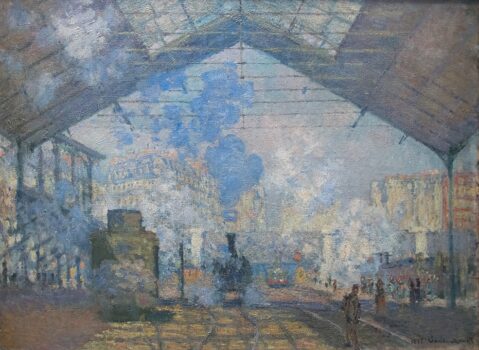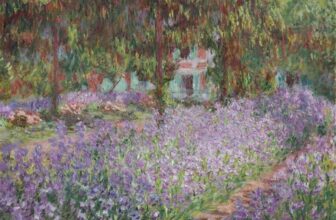Meaning of A Monet’s Saint Lazare Painting
In the heart of the 19th century, as the world thundered into the modern era on rails of steel and clouds of smoke, one artist stood on the platform of progress and captured the raw pulse of change with his paintbrush. That artist was Claude Monet, and his Gare Saint-Lazare series remains one of the most compelling visual poems to industrial modernity ever painted.
But what is Gare Saint-Lazare really about? How did Monet approach such a dynamic and complex subject? What does the painting represent, and why has it become such a significant cultural artifact in the canon of art history? This is a journey into the very steam-filled soul of Impressionism, guided by one of its most evocative works.
What Is Gare Saint-Lazare?
First, let’s establish what we mean when we refer to Gare Saint-Lazare. Technically, this title refers to a series of twelve paintings created by Claude Monet in 1877, all depicting views of the Gare Saint-Lazare, one of Paris’s largest and busiest train stations.
The most famous painting in the series is often simply called La Gare Saint-Lazare (sometimes subtitled The Arrival of a Train), which is held today at the Musée d’Orsay in Paris. This iconic work shows a train emerging through a cloud of vapor beneath the cavernous iron and glass roof of the station.
Rather than a singular, tightly detailed architectural rendering, Monet presents the station as a misty, almost ephemeral realm where steam, smoke, light, and movement dance together in a symphony of brushstrokes. This is not just a painting of a place, it is a painting of an atmosphere, a moment suspended in flux.
To understand Gare Saint-Lazare, we must first understand the time in which it was painted.
Paris in the 1870s was undergoing radical transformation. The Second Empire had given way to the Third Republic following the Franco-Prussian War and the Paris Commune. Baron Haussmann’s massive renovation project had already reshaped the city into a beacon of modern urban planning, and the railway was the bloodstream of this new world.
The Gare Saint-Lazare itself was a marvel of modern engineering, a cathedral of iron and glass, humming with industry and connecting the capital to the expanding peripheries of France. Trains represented not only new technology but also a symbol of speed, change, and the collapse of rural isolation.
Artists like Monet, who were on the cutting edge of the avant-garde, were fascinated by these symbols of modernity. While earlier generations of painters had focused on myth, religion, or aristocratic portraiture, Monet and his fellow Impressionists turned their gaze toward the everyday life of modern France, and they did so with a radical new technique.
The Art of Impressionism
Monet was one of the founding fathers of the Impressionist movement, a style characterized by loose brushwork, vivid colors, visible strokes, and an emphasis on capturing light and fleeting moments rather than polished realism.
Impressionism was not just a style; it was a philosophy of seeing. Instead of creating art in studios, Impressionists painted en plein air (outdoors), seeking to depict how light and color change over time. It was about capturing the impression of a scene, the sensory, emotional, and visual response in real time.
With Gare Saint-Lazare, Monet brought this ethos into the heart of industrial life. It was a bold move: no one had ever made something as functional and utilitarian as a train station the subject of high art. But Monet saw beauty in the unexpected, in the billows of steam, the gleam of iron, and the play of sunlight through sooty clouds.
How Monet Painted Gare Saint-Lazare
In 1877, Monet rented a small apartment near the station specifically to work on this series. He was 36 years old and already somewhat known for his depictions of natural landscapes, water lilies, and outdoor scenes.
Unlike his previous open-air subjects, Monet was now confronted with a world of machinery, noise, and grime. Yet he approached it with the same sensitivity to light and color that he applied to fields and rivers.
Monet gained permission from the station authorities to paint within the actual Gare Saint-Lazare terminal. He set up his easel directly on the platform, sketching and painting as trains arrived and departed, belching steam and churning with energy. At times, he would even request the release of extra steam from locomotives to create the atmospheric effects he desired.
He worked quickly, often finishing multiple canvases at once. Instead of depicting precise architectural detail, he focused on movement, light, and transformation, elements that reflected the Impressionist obsession with the ephemeral.
The result is a series of deeply atmospheric works that seem to vibrate with energy. Smoke and steam are treated almost as light sources themselves, softening the hard lines of the station and transforming the entire scene into something dreamlike and transient.
What Is Happening in the Painting?
In the best-known version, the viewer sees a steam train emerging from a cloud of smoke, with figures dotting the platform in the distance. The massive iron roof of the station stretches above like a great ribcage. Sunlight filters through the smoke and glass, dousing the scene in a luminous haze.
There is no clear narrative, no story in the traditional sense. Rather, the painting captures a moment. The train has just arrived or is about to depart; the air is thick with vapor; commuters blur into suggestion. The viewer is invited to feel the sense of anticipation, movement, and anonymity that characterizes the modern urban experience.
It is a masterful rendering of both space and time. There is motion, atmosphere, and uncertainty, yet also a strange serenity. The mechanical and the ethereal coexist.
Symbolism and Deeper Meaning
On the surface, Gare Saint-Lazare may appear to be merely a technical feat, an artist’s response to a changing cityscape. But below the surface lies a wealth of symbolism and meaning.
The Train as a Symbol of Modernity: The steam engine, a marvel of the industrial revolution, represents the unstoppable momentum of modern progress. By painting it not as an object of fear or awe, but as a source of beauty, Monet is embracing the modern world rather than resisting it.
Smoke as Transformation: Steam and smoke, recurring motifs in the painting, serve as symbols of impermanence. They mask and reveal, distort and transform. This duality echoes the Impressionist aim to capture the fleeting and the intangible.
The Urban Environment as a Natural Landscape: Monet treats the iron and stone of the station with the same reverence he gives to trees and rivers. In doing so, he elevates the industrial setting to the realm of the sublime. It’s as if the station is a new kind of forest, with locomotives for wildlife and smoke for mist.
Anonymity and Alienation: The human figures in the painting are small and indistinct, dwarfed by the machines and architecture. This reflects a common theme in modern art, the loss of individual identity in the face of industrial expansion.
Light as a Spiritual Element: The way Monet captures sunlight filtering through the vapor imbues the scene with an almost religious atmosphere. The train station becomes a cathedral, and the light its divine presence.
What Type of Art Is Gare Saint-Lazare?
The painting is a quintessential example of French Impressionism. However, it also foreshadows later artistic movements such as Modernism and even Abstract Expressionism, particularly in the way Monet blurs the boundaries between form and formlessness.
Its emphasis on subjective experience, non-traditional subject matter, and innovative use of color and light makes it a cornerstone of the transition from classical to contemporary art.
Some art historians even argue that this series helped redefine what painting could be, not just a mirror to reality, but a meditation on perception itself.
Where Is Gare Saint-Lazare Painting Today?
Of the twelve paintings in the Gare Saint-Lazare series, several are held in major museums around the world. The most famous and frequently referenced version resides at the Musée d’Orsay in Paris.
Others can be found in:
Harvard Art Museums, Cambridge, Massachusetts
Fogg Art Museum, USA
Art Institute of Chicago, USA
National Gallery, London
Musée Marmottan Monet, Paris
Each version offers a slightly different angle or mood, some focus more on the exterior of the station, others on the platforms, others on the trains themselves. Together, they form a unified vision of a single space seen through the prism of light, time, and emotion.
The Soul of the Industrial Age
Claude Monet’s Gare Saint-Lazare is a visual symphony of light, movement, and transformation. It captures the very essence of a world in flux, at the threshold of the old and the new.
By choosing to depict the machinery of modern life not with fear or reverence but with beauty and sensitivity, Monet challenges us to see the poetry in progress. The station becomes a landscape, the train a creature of breath and muscle, and the smoke a metaphor for the impermanence of all things.
Even today, in a world defined by digital rather than steam power, the Gare Saint-Lazare series continues to resonate. It reminds us that art does not merely reflect the world, it refracts it, transforms it, and reveals its hidden rhythms.
In Monet’s eyes, the train station was not just a terminal, it was a beginning.




